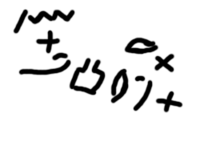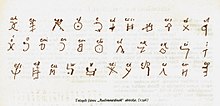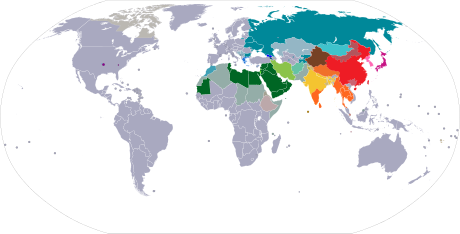Alphabet theme by Nathanael McDaniel
Download: Alphabet.p3t

(1 background)
An alphabet is a standard set of letters written to represent particular sounds in a spoken language. Specifically, letters correspond to phonemes, the categories of sounds that can distinguish one word from another in a given language.[1] Not all writing systems represent language in this way: a syllabary assigns symbols to spoken syllables, while logographies assign symbols to words, morphemes, or other semantic units.[2][3]
The first letters were invented in Ancient Egypt to serve as an aid in writing Egyptian hieroglyphs; these are referred to as Egyptian uniliteral signs by lexicographers.[4] This system was used until the 5th century AD,[5] and fundamentally differed by adding pronunciation hints to existing hieroglyphs that had previously carried no pronunciation information. Later on, these phonemic symbols also became used to transcribe foreign words.[6] The first fully phonemic script was the Proto-Sinaitic script, also descending from Egyptian hieroglyphics, which was later modified to create the Phoenician alphabet. The Phoenician system is considered the first true alphabet and is the ultimate ancestor of many modern scripts, including Arabic, Cyrillic, Greek, Hebrew, Latin, and possibly Brahmic.[7][8][9][10]

Peter T. Daniels distinguishes true alphabets—which use letters to represent both consonants and vowels—from both abugidas and abjads, which only need letters for consonants. Abjads generally lack vowel indicators altogether, while abugidas represent them with diacritics added to letters. In this narrower sense, the Greek alphabet was the first true alphabet;[11][12] it was originally derived from the Phoenician alphabet, which was an abjad.[13]
Alphabets usually have a standard ordering for their letters. This makes alphabets a useful tool in collation, as words can be listed in a well-defined order—commonly known as alphabetical order. This also means that letters may be used as a method of "numbering" ordered items. Letters also have names in some languages; this is known as acrophony, and it is present in scripts including Greek, Arabic, Hebrew, and Syriac. However, acrophony is not present in all languages, such as the Latin alphabet, which simply adds a vowel after the character representing each letter. Some systems also used to have acrophony but later abandoned it, such as Cyrillic.
Etymology[edit]
The English word alphabet came into Middle English from the Late Latin word alphabetum, which in turn originated in the Greek, ἀλφάβητος (alphábētos); it was made from the first two letters of the Greek alphabet, alpha (α) and beta (β).[14] The names for the Greek letters, in turn, came from the first two letters of the Phoenician alphabet: aleph, the word for ox, and bet, the word for house.[15]
History[edit]
[edit]
Ancient Near Eastern alphabets[edit]
The Ancient Egyptian writing system had a set of some 24 hieroglyphs that are called uniliterals,[16] which are glyphs that provide one sound.[17] These glyphs were used as pronunciation guides for logograms, to write grammatical inflections, and, later, to transcribe loan words and foreign names.[6] The script was used a fair amount in the 4th century CE.[18] However, after pagan temples were closed down, it was forgotten in the 5th century until the discovery of the Rosetta Stone.[5] There was also cuneiform, primarily used to write several ancient languages, including Sumerian.[19] The last known use of the Cuneiform script was in 75 CE, after which the script fell out of use.[20] In the Middle Bronze Age, an apparently alphabetic system known as the Proto-Sinaitic script appeared in Egyptian turquoise mines in the Sinai peninsula around 1840 BCE, apparently left by Canaanite workers. Orly Goldwasser has connected the illiterate turquoise miner graffiti theory to the origin of the alphabet.[9] In 1999, American Egyptologists John and Deborah Darnell discovered an earlier version of this first alphabet at the Wadi el-Hol valley. The script dated to c. 1800 BCE and shows evidence of having been adapted from specific forms of Egyptian hieroglyphs that could be dated to c. 2000 BCE, strongly suggesting that the first alphabet had developed about that time.[21] The script was based on letter appearances and names, believed to be based on Egyptian hieroglyphs.[7] This script had no characters representing vowels. Originally, it probably was a syllabary—a script where syllables are represented with characters—with symbols that were not needed being removed. The best-attested Bronze Age alphabet is Ugaritic, invented in Ugarit before the 15th century BCE. This was an alphabetic cuneiform script with 30 signs, including three that indicate the following vowel. This script was not used after the destruction of Ugarit in 1178 BCE.[22]

The Proto-Sinaitic script eventually developed into the Phoenician alphabet, conventionally called Proto-Canaanite, before c. 1050 BCE.[8] The oldest text in Phoenician script is an inscription on the sarcophagus of King Ahiram c. 1000 BCE. This script is the parent script of all western alphabets. By the 10th century BCE, two other forms distinguish themselves, Canaanite and Aramaic. The Aramaic gave rise to the Hebrew alphabet.[23]
The South Arabian alphabet, a sister script to the Phoenician alphabet, is the script from which the Ge'ez abugida was descended. Abugidas are writing systems with characters comprising consonant–vowel sequences. Alphabets without obligatory vowels are called abjads, with examples being Arabic, Hebrew, and Syriac. The omission of vowels was not always a satisfactory solution due to the need of preserving sacred texts. "Weak" consonants are used to indicate vowels. These letters have a dual function since they can also be used as pure consonants.[24][25]
The Proto-Sinaitic script and the Ugaritic script were the first scripts with a limited number of signs instead of using many different signs for words, in contrast to cuneiform, Egyptian hieroglyphs, and Linear B. The Phoenician script was probably the first phonemic script,[7][8] and it contained only about two dozen distinct letters, making it a script simple enough for traders to learn. Another advantage of the Phoenician alphabet was that it could write different languages since it recorded words phonemically.[26]
The Phoenician script was spread across the Mediterranean by the Phoenicians.[8] The Greek Alphabet was the first alphabet in which vowels have independent letter forms separate from those of consonants. The Greeks chose letters representing sounds that did not exist in Phoenician to represent vowels. The Linear B syllabary, used by Mycenaean Greeks from the 16th century BCE, had 87 symbols, including five vowels. In its early years, there were many variants of the Greek alphabet, causing many different alphabets to evolve from it.[27]
European alphabets[edit]
The Greek alphabet, in Euboean form, was carried over by Greek colonists to the Italian peninsula c. 800-600 BCE giving rise to many different alphabets used to write the Italic languages, like the Etruscan alphabet.[28] One of these became the Latin alphabet, which spread across Europe as the Romans expanded their republic. After the fall of the Western Roman Empire, the alphabet survived in intellectual and religious works. It came to be used for the descendant languages of Latin (the Romance languages) and most of the other languages of western and central Europe. Today, it is the most widely used script in the world.[29]
The Etruscan alphabet remained nearly unchanged for several hundred years. Only evolving once the Etruscan language changed itself. The letters used for non-existent phonemes were dropped.[30] Afterwards, however, the alphabet went through many different changes. The final classical form of Etruscan contained 20 letters. Four of them are vowels (a, e, i, and u) - six fewer letters than the earlier forms. The script in its classical form was used until the 1st century CE. The Etruscan language itself was not used in imperial Rome, but the script was used for religious texts.[31]
Some adaptations of the Latin alphabet have ligatures, a combination of two letters make one, such as æ in Danish and Icelandic and Ȣ in Algonquian; borrowings from other alphabets, such as the thorn þ in Old English and Icelandic, which came from the Futhark runes;[32] and modified existing letters, such as the eth ð of Old English and Icelandic, which is a modified d. Other alphabets only use a subset of the Latin alphabet, such as Hawaiian and Italian, which uses the letters j, k, x, y, and w only in foreign words.[33]
Another notable script is Elder Futhark, believed to have evolved out of one of the Old Italic alphabets. Elder Futhark gave rise to other alphabets known collectively as the Runic alphabets. The Runic alphabets were used for Germanic languages from 100 CE to the late Middle Ages, being engraved on stone and jewelry, although inscriptions found on bone and wood occasionally appear. These alphabets have since been replaced with the Latin alphabet. The exception was for decorative use, where the runes remained in use until the 20th century.[34]

The Old Hungarian script was the writing system of the Hungarians. It was in use during the entire history of Hungary, albeit not as an official writing system. From the 19th century, it once again became more and more popular.[35]
The Glagolitic alphabet was the initial script of the liturgical language Old Church Slavonic and became, together with the Greek uncial script, the basis of the Cyrillic script. Cyrillic is one of the most widely used modern alphabetic scripts and is notable for its use in Slavic languages and also for other languages within the former Soviet Union. Cyrillic alphabets include Serbian, Macedonian, Bulgarian, Russian, Belarusian, and Ukrainian. The Glagolitic alphabet is believed to have been created by Saints Cyril and Methodius, while the Cyrillic alphabet was created by Clement of Ohrid, their disciple. They feature many letters that appear to have been borrowed from or influenced by Greek and Hebrew.[36]
Asian alphabets[edit]
Many phonetic scripts exist in Asia. The Arabic alphabet, Hebrew alphabet, Syriac alphabet, and other abjads of the Middle East are developments of the Aramaic alphabet.[37][38]
Most alphabetic scripts of India and Eastern Asia descend from the Brahmi script, believed to be a descendant of Aramaic.[39]
European alphabets, especially Latin and Cyrillic, have been adapted for many languages of Asia. Arabic is also widely used, sometimes as an abjad, as with Urdu and Persian, and sometimes as a complete alphabet, as with Kurdish and Uyghur.[40][41]
Other alphabets[edit]
Hangul[edit]
In Korea, Sejong the Great created the Hangul alphabet in 1443 CE.[42] Hangul is a unique alphabet: it is a featural alphabet, where the design of many of the letters comes from a sound's place of articulation, like P looking like the widened mouth and L looking like the tongue pulled in.[43] The creation of Hangul was planned by the government of the day,[44] and it places individual letters in syllable clusters with equal dimensions, in the same way as Chinese characters. This change allows for mixed-script writing, where one syllable always takes up one type space no matter how many letters get stacked into building that one sound-block.[45]
Zhuyin[edit]
Zhuyin, sometimes referred to as Bopomofo, is a semi-syllabary. It transcribes Mandarin phonetically in the Republic of China. After the later establishment of the People's Republic of China and its adoption of Hanyu Pinyin, the use of Zhuyin today is limited. However, it is still widely used in Taiwan. Zhuyin developed from a form of Chinese shorthand based on Chinese characters in the early 1900s and has elements of both an alphabet and a syllabary. Like an alphabet, the phonemes of syllable initials are represented by individual symbols, but like a syllabary, the phonemes of the syllable finals are not; each possible final (excluding the medial glide) has its own character, an example being luan written as ㄌㄨㄢ (l-u-an). The last symbol ㄢ takes place as the entire final -an. While Zhuyin is not a mainstream writing system, it is still often used in ways similar to a romanization system, for aiding pronunciation and as an input method for Chinese characters on computers and cellphones.[46]
Types[edit]
The term "alphabet" is used by linguists and paleographers in both a wide and a narrow sense. In a broader sense, an alphabet is a segmental script at the phoneme level—that is, it has separate glyphs for individual sounds and not for larger units such as syllables or words. In the narrower sense, some scholars distinguish "true" alphabets from two other types of segmental script, abjads, and abugidas. These three differ in how they treat vowels. Abjads have letters for consonants and leave most vowels unexpressed. Abugidas are also consonant-based but indicate vowels with diacritics, a systematic graphic modification of the consonants.[47] The earliest known alphabet using this sense is the Wadi el-Hol script, believed to be an abjad. Its successor, Phoenician, is the ancestor of modern alphabets, including Arabic, Greek, Latin (via the Old Italic alphabet),

